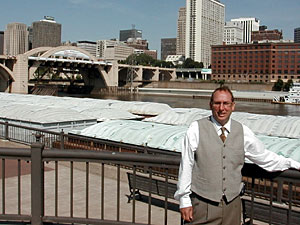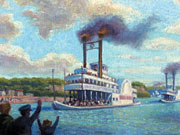| The Grand Excursion |
A cleaner Mississippi River faces new pollution challenges
July 2, 2004
 |
| JLT Group vice president Bob Kowalski says his company's billion dollar riverfront proposal for St. Paul's west side includes housing and shopping (MPR photo/Dan Olson) |
St. Paul, Minn. — The cleaner Mississippi is a big part of the riverfront's burgeoning public appeal. The cleanup picked up speed with the l972 federal Clean Water Act. Governments at every level collectively spent billions. A good share of the money went to separating and treating raw municipal sewage that had been dumped into the river.
The results are dramatic.
Water laps gently on a sugar sand riverfront beach at Hidden Falls Crosby Regional Park just a few minutes from downtown St. Paul. Towering cottonwood, maple and oak trees create a four-story high green canopy overhead and deep pools of shade below.
 | |||
Preservationists worry the wave of development taking hold along the Twin Cities portion of Mississippi riverfront means more trees and plants will be replaced with millions of square feet of rooftops and parking lots topped with asphalt and concrete.
The worries are well founded.
Explosion is not too strong a word to describe the level of development along the river.
There are more than 50 proposals for private and public sector projects in the works. The majority are large residential projects that will create thousands of homes, condominiums and apartments along the riverfront.
 | |||
One of the most controversial is Rivers Edge just south of the city of St. Paul near suburban St. Paul Park.
The developers want to build on a scenic backwater bay called Crystal Cove. The bay is ringed by limestone bluffs topped with a thick growth of hardwood trees.
The developers and St. Paul Park are being sued by the Minnesota Center for Environmental Advocacy. The MCEA's Jim Erkel says the proposal violates federal and state rules designed to protect the rural nature of the cove and the bluffs. Erkel says their suit is an attempt to have a court uphold the rules.
"It would allow residential low density development of about 1 unit per 10 acres. In contrast Rivers Edge would build 2400 units right on the bluffs overlooking the Mississippi," he says.
 | |||
The Rivers Edge developer and the City of St. Paul Park declined comment on the lawsuit and the status of Rivers Edge.
The proposal is one of dozens in the works now that the river is cleaner and has become a prestigious address.
Upstream and closer to downtown St. Paul, a development already in the ground is a collection of dozens of luxury homes in a new gated community. The homes are on a bluff overlooking the Mississippi River in Lilydale.
On a driving tour of the neighborhood, National Park Service spokesman Steve Johnson says the builder is pushing state and federal riverfront construction rules to the limit.
 | |||
"The structure-high limit is 35 feet and I think they've gone right to the max. And the setback requirement is 40 feet from the bluff line. When we reviewed the site plan they met that but only barely," Johnson says.
The federal and state rules are part of a 30-year-old plan to guide development along the Twin Cities portion of the Mississippi. The first state rules were created during the administrations of former governors Wendell Anderson and Al Quie. Federal rules came a few years later. But the protection is limited.
The Mississippi is, after all, a working river.
Seven percent of the country's grain moves downriver to the Gulf of Mexico in barges filled at Twin Cities area ports. And every day dozens of trains carrying, coal, automobiles and other cargo move along tracks a few feet from the rivers edge in downtown St. Paul.
But the industrial uses are declining. They're being replaced by housing and entertainment. The boldest proposal is St. Paul-based JLT Group's billion dollar venture.
JLT vice president Bob Kowalski says they want to build hundreds of thousands of square feet of retail space, thousands of units of housing and a marina on 75 acres of riverfront land on St. Paul's west side. Kowalski says the plan will allow people to use a span of riverfront now occupied by parked barges.
"We can walk along, as we can see here, the promenade but we can't get down to the river, there's no docks, there's no boating access here," he says.
JLT Group's downtown St. Paul plan, the luxury homes in the gated Lilydale neighborhood and the proposed Rivers Edge Development near St. Paul Park will generate property tax revenue for their respective cities. They are far more desirable riverfront activities than the livestock slaughter houses, scrap yards and heavy industry sites which once dotted the shoreline and helped make the Mississippi an open sewer.
However, Deborah Karasov, executive director of the St. Paul-based advocacy group, Great River Greening says the riverfront won't survive the new wave of development unless companies and cities change their ways. Karasov is a landscape architect and St. Paul native. With the backing of the St. Paul Port Authority, Great River Greening encourages businesses to capture and retain runoff water which picks up parking lot pollution and speeds riverbank erosion.
"(We use) rain gardens, swails, very high functioning ponds, we sometimes put biofilters on the ponds, anything that we can do to improve the site storm water management," she says.
Karasov says they work with developers and homeowners to retain and restore the canopy of old growth forest still found in patches along the riverfront. Great River Greening staff and volunteers have planted more than 35,000 trees native to the riverfront.
A good share of their work, Karasov says, boils down to the mundane task of controlling invasive species such as buckthorn which crowd out native trees.
"On parts of the Mississippi river bluff where you see those beautiful trees that are 40, 50 years old, as they die new ones would not be able to grow. What you would have eventually in the next 40 to 50 years is a thick hedge of buckthorn," she says.
Riverboat passengers on the first Grand Excursion of l854 arrived in St. Paul when the Mississippi was a largely unspoiled, undeveloped river. The century of development that followed was an environmental disaster. Thirty years of cleanup have improved conditions. The river is attracting people like never before. The attention is spurring interest in avoiding the environmental mistakes made by past generations.
|
News Headlines
|
Related Subjects
|

